Physical Address
304 North Cardinal St.
Dorchester Center, MA 02124
A brief review of the development and anatomy of the female genital tract is fundamental to understanding the diseases that affect this complex organ system. Normal development of the female genital tract proceeds through a series of tightly choreographed events involving the primordial germ cells, the müllerian (paramesonephric) ducts, the wolffian (mesonephric) ducts, and the urogenital sinus ( Fig. 22.1 ).
Germ cells arise in the wall of the yolk sac by the fourth week of gestation. By the fifth or sixth week, they migrate into the urogenital ridge and induce proliferation of the mesodermal epithelium, which gives rise to the epithelium and stroma of the ovary.
The lateral müllerian ducts form at about the sixth week of development through invagination and fusion of the coelomic lining epithelium. The ducts progressively grow caudally into the pelvis, where they swing medially to fuse with the urogenital sinus at the müllerian tubercle (see Fig. 22.1A ). Further caudal growth brings these fused ducts into contact with the urogenital sinus. The unfused upper portions of the müllerian ducts mature into the fallopian tubes, while the fused lower portion develops into the uterus, cervix, and upper vagina.
The urogenital sinus develops when the cloaca is subdivided by the urorectal septum; it eventually forms the lower part of the vagina and the vestibule of the external genitalia (see Fig. 22.1B ).
The mesonephric ducts normally regress in the female, but remnants may persist into adult life as epithelial inclusions adjacent to the ovaries, tubes, and uterus. In the cervix and vagina, these rests may be cystic and are termed Gartner duct cysts .
The epithelial lining of the female genital tract as well as the ovarian surface share a common origin from coelomic epithelium (mesothelium), which may explain why morphologically similar benign and malignant lesions arise in various sites within the female genital tract and the adjacent peritoneal surfaces.
Diseases of the female genital tract are extremely common and include complications of pregnancy, infections, tumors, and hormonally induced abnormalities. The following discussion presents the pathology of the major diseases that result in clinical problems. Additional details can be found in current textbooks of gynecologic pathology and clinical obstetrics and gynecology. We will discuss the pathologic conditions peculiar to each segment of the female genital tract separately, but before doing so we will briefly review infections and pelvic inflammatory disease because they can affect many of the various anatomic structures concomitantly.
A large variety of organisms can infect the female genital tract. Some infections with microorganisms such as Candida, Trichomonas, and Gardnerella are very common and may cause significant discomfort, but are without serious sequelae. Others, such as Neisseria gonorrhoeae and Chlamydia infections, are major causes of infertility, while organisms such as Group B Streptococcus infections are implicated in preterm deliveries, stillbirths, and neonatal infections. Viruses, especially herpes simplex viruses (HSVs) and human papillomaviruses (HPVs), also account for considerable morbidity; HSVs cause painful genital ulcerations, whereas HPVs are involved in the pathogenesis of cervical, vaginal, and vulvar cancers (described later).
Many of these infections are sexually transmitted, including trichomoniasis, gonorrhea, Mycoplasma, Chlamydia, HSV, and HPV as well as less common infections such as syphilis, chancroid, granuloma inguinale, and lymphogranuloma venereum. Most of these conditions are considered in Chapter 8 ; HPV is also discussed in Chapter 7 due to its important role as a transforming virus. Here we touch only on aspects relevant to the female genital tract, including pathogens confined to the lower genital tract (vulva, vagina, and cervix) and those that involve the entire genital tract and are implicated in pelvic inflammatory disease.
Genital herpes simplex virus (HSV) infection is common and may involve the vulva, vagina, or cervix. HSVs are DNA viruses that include two serotypes, HSV-1 and HSV-2. HSV-1 typically results in perioral infection, whereas HSV-2 usually involves genital mucosa and skin; however, depending on sexual practices, HSV-1 may be detected in the genital region and HSV-2 may cause oral infections as well ( Chapter 8 ). By 40 years of age, approximately 30% of women are seropositive for antibodies against HSV-2.
About one-third of newly infected individuals are symptomatic. Lesions typically develop 3 to 7 days after transmission and are often associated with systemic symptoms such as fever, malaise, and tender inguinal lymph nodes. The earliest lesions usually consist of red papules that progress to vesicles and then to painful coalescent ulcers. The lesions are easily visible on vulvar skin and mucosa, while cervical and vaginal lesions present with purulent discharge and pelvic pain. Lesions around the urethra may cause painful urination and urine retention. The vesicles and ulcers contain numerous viral particles, accounting for the high transmission rate during active infection. The mucosal and cutaneous lesions heal spontaneously in 1 to 3 weeks, but during the acute infection the virus migrates to the regional lumbosacral nerve ganglia and establishes a latent infection. Because of viral latency, HSV infections persist indefinitely, and any decrease in immune function due to stress, trauma, concurrent viral infection, or hormonal changes can trigger reactivation of the virus and recurrence of the skin and mucosal lesions. As expected, recurrences are much more common in immunosuppressed individuals.
By the time an HSV lesion is biopsied, it typically has ulcerated. The epithelium is desquamated, and marked acute inflammation is present in the ulcer bed. Smears of the inflammatory exudate from active lesions show characteristic cytopathic changes consisting of multinucleated squamous cells containing eosinophilic to basophilic viral inclusions with a “ground-glass” appearance ( Fig. 22.2 ).
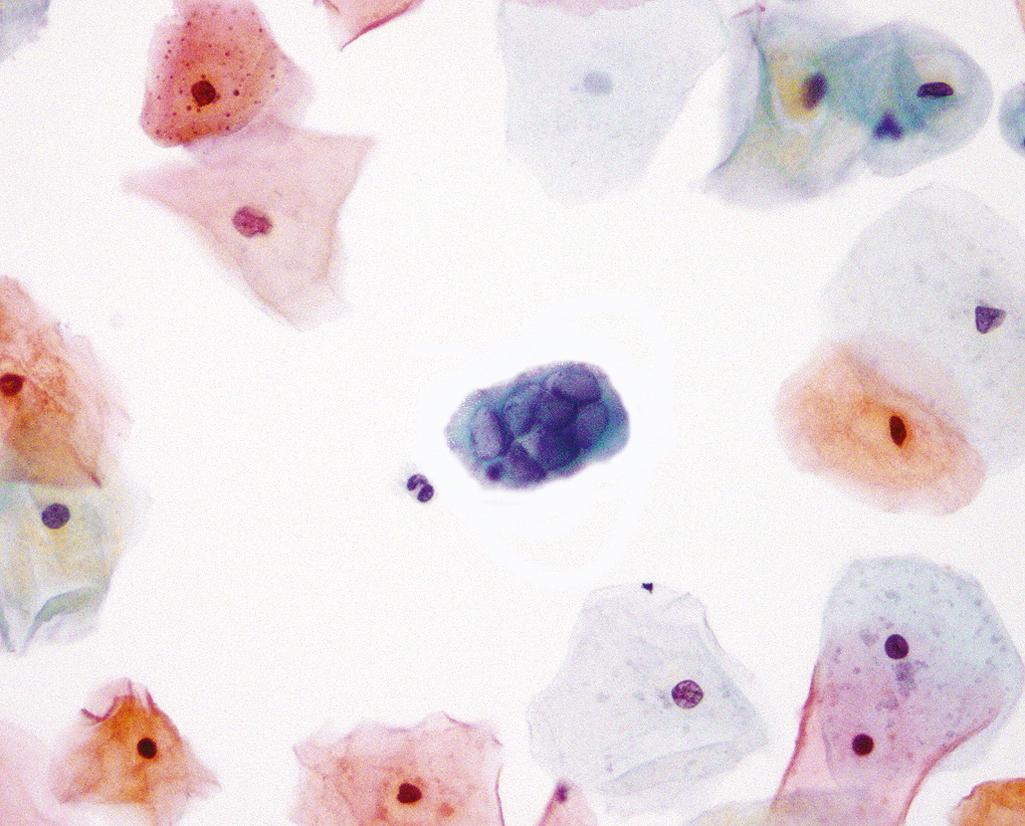
Transmission of HSV takes place mainly during the active phase but occasionally may occur during the latent phase due to subclinical virus shedding. Condoms and antiviral therapies reduce the risk of transmission, but do not prevent it completely. As with other sexually transmitted diseases, the virus is more readily transmitted to women than to men. Previous infection with HSV-1 seems to reduce susceptibility to HSV-2 infection. The gravest consequence of HSV infection is transmission to the neonate during birth. This risk is highest if the infection is active during delivery and particularly if it is a primary (initial) infection in the mother. Cesarean delivery is warranted in such cases to prevent transmission to the neonate. Another important consequence of active genital HSV infection is that it increases the risk of HIV-1 acquisition and transmission.
The diagnosis is based on typical clinical findings and HSV detection. The purulent exudate is aspirated from the lesions and inoculated into a tissue culture. The viral cytopathic effect can be seen after 48 to 72 hours, and the virus can then be serotyped. In addition, some laboratories offer more sensitive polymerase chain reaction tests, enzyme-linked immunosorbent assays, and direct immunofluorescent antibody tests for detection of HSV in the lesional secretions. Individuals with primary, acute HSV infection do not have serum anti-HSV antibodies. Detection of anti-HSV antibodies in the serum is indicative of recurrent/latent infection.
There is no effective treatment for latent HSV; however, antiviral agents like acyclovir or famciclovir shorten the length of the initial and recurrent symptomatic phases. The ultimate solution is an effective vaccine, a tantalizing goal yet to be realized .
As mentioned earlier, a variety of other viruses, fungi, and bacteria can also cause symptomatic infections of the lower genital tract. Those that are most common include the following:
Molluscum contagiosum is a cutaneous or mucosal lesion caused by poxvirus ( Fig. 22.3A ). There are four types of molluscum contagiosum viruses (MCVs), MCV-1 to MCV-4, with MCV-1 being the most prevalent and MCV-2 being most often sexually transmitted. The infections are common in young children between 2 and 12 years of age, in whom they are transmitted through direct contact or shared articles (e.g., towels). Molluscum may affect any area of the skin but is most common on the trunk, arms, and legs. In adults, molluscum infections are typically sexually transmitted and affect the genitals, lower abdomen, buttocks, and inner thighs. The average incubation period is 6 weeks. Diagnosis is based on the characteristic clinical appearance of pearly, dome-shaped papules with a dimpled center. The papules measure 1 to 5 mm in diameter, and their central waxy core contains cells with cytoplasmic viral inclusions (see Fig. 22.3B ).
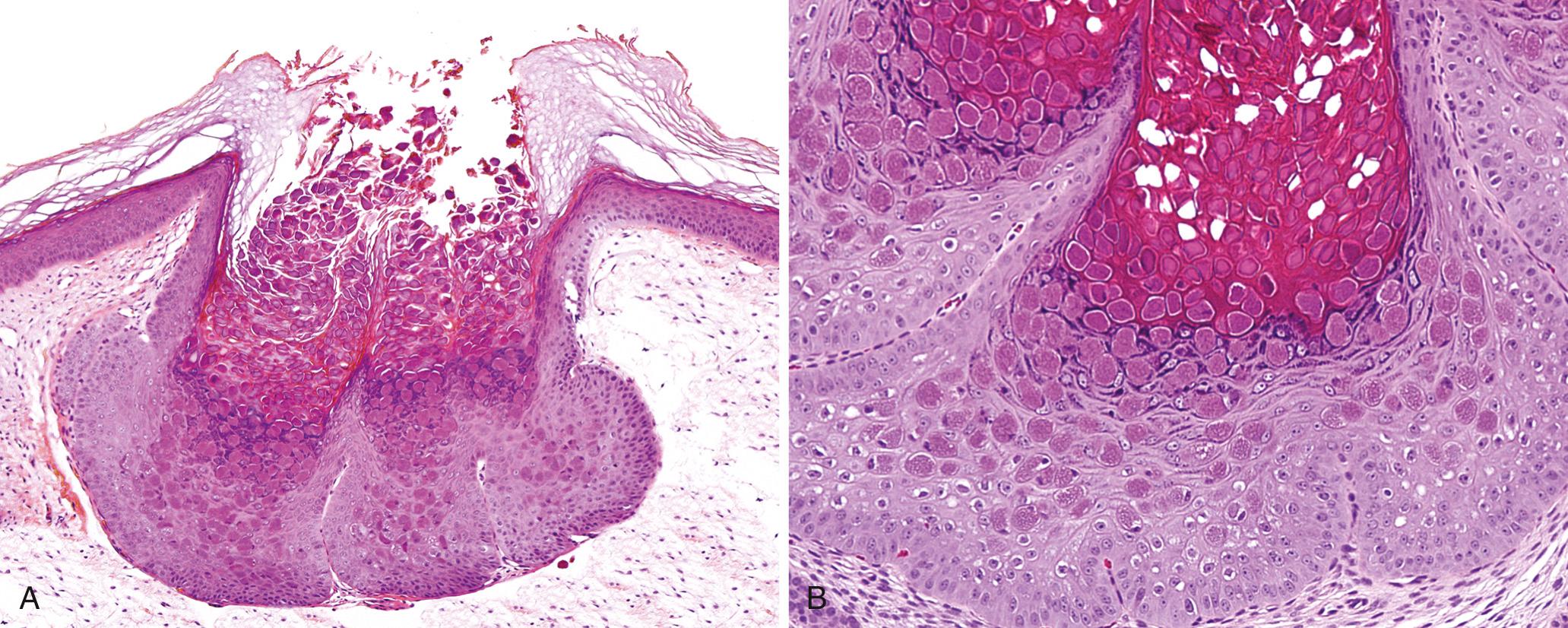
Fungal infections, especially those caused by yeast (Candida), are extremely common; in fact, yeast are part of many women's normal vaginal microflora, and the development of symptomatic candidiasis is typically a result of a disturbance in the patient's vaginal microbial ecosystem. Diabetes mellitus, antibiotics, pregnancy, and conditions that compromise neutrophil or Th17 T-cell function increase the risk of symptomatic candidal infection , which manifests itself by marked vulvovaginal pruritus, erythema, swelling, and curdlike vaginal discharge. Severe infection may result in mucosal ulcerations. The diagnosis is made by finding the pseudospores or filamentous fungal hyphae in wet KOH mounts of the discharge or on Papanicolaou (Pap) smear. Even though sexual transmission of yeast infection has been documented, candidiasis is not considered a sexually transmitted disease.
Trichomonas vaginalis is a large, flagellated ovoid protozoan that is usually transmitted by sexual contact. Infected patients may be asymptomatic or may complain of yellow, frothy vaginal discharge, vulvovaginal discomfort, dysuria (painful urination), and dyspareunia (painful intercourse). The vaginal and cervical mucosa typically has a fiery-red appearance, with marked dilation of cervical mucosal vessels resulting in characteristic colposcopic appearance of “strawberry cervix.”
Gardnerella vaginalis is a gram-negative coccobacillus that is implicated as the main cause of bacterial vaginosis (vaginitis). Patients typically present with thin, green-gray, malodorous (fishy) vaginal discharge. Pap smears reveal superficial and intermediate squamous cells covered with a shaggy coat of coccobacilli. Bacterial cultures in such cases reveal G. vaginalis and other bacteria, including anaerobic peptostreptococci and aerobic α-hemolytic streptococci. In pregnant patients, bacterial vaginosis has been implicated in premature labor.
Ureaplasma urealyticum and Mycoplasma hominis species account for some cases of vaginitis and cervicitis and have been implicated in chorioamnionitis and premature delivery in pregnant patients.
Chlamydia trachomatis infections mainly take the form of cervicitis. However, in some patients the infection may ascend to the uterus and fallopian tubes, resulting in endometritis and salpingitis; thus Chlamydia is one of the causes of pelvic inflammatory disease, as discussed next.
PID is an infection that begins in the vulva or vagina and spreads upward to involve most of the structures in the female genital system, resulting in pelvic pain, adnexal tenderness, fever, and vaginal discharge. Neisseria gonorrhoeae continues to be a common cause of PID, the most serious complication of gonorrhea in women. Chlamydia infection is another well-recognized cause of PID. Infections after spontaneous or induced abortions and normal or abnormal deliveries (called puerperal infections ) are also important causes of PID. In these situations, the infections are typically polymicrobial and may be caused by staphylococci, streptococci, coliforms, and Clostridium perfringens .
With gonococcus, inflammatory changes start to appear approximately 2 to 7 days after inoculation. The initial infection most commonly involves the endocervical mucosa, but it may also begin in the Bartholin gland and other vestibular, or periurethral, glands. From these sites, the organisms may spread upward to involve the fallopian tubes and tubo-ovarian region. The non-gonococcal bacterial infections that follow induced abortion, dilation and curettage of the uterus, and other surgical procedures are thought to spread upward from the uterus through the lymphatics or venous channels rather than on the mucosal surfaces. Therefore, these infections tend to produce more inflammation within the deeper layers of the organs than gonococcal infections.
Gonococcal infection is characterized by marked acute inflammation of involved mucosal surfaces. Smears of the inflammatory exudate disclose phagocytosed gram-negative diplococci within neutrophils; however, definitive diagnosis requires culture or detection of gonococcal RNA or DNA. If infection spreads, the endometrium is usually spared (for unclear reasons), but within the fallopian tubes, an acute suppurative salpingitis ensues ( Fig. 22.4A ). The tubal mucosa becomes congested and diffusely infiltrated by neutrophils, plasma cells, and lymphocytes, resulting in epithelial injury and sloughing of the plicae. The tubal lumen fills with purulent exudate that may leak out of the fimbriated end. The infection may then spread to the ovary to create a salpingo-oophoritis. Collections of pus may accumulate within the ovary and tube (tubo-ovarian abscess) or tubal lumen (pyosalpinx) (see Fig. 22.4A ). With time, the infecting organisms may disappear, but the tubal plicae, denuded of epithelium, adhere to one another and slowly fuse in a reparative, scarring process that forms glandlike spaces and blind pouches, referred to as chronic salpingitis (see Fig. 22.4B ). The scarring of the tubal lumen and fimbriae may prevent the uptake and passage of oocytes, leading to infertility or ectopic pregnancy. Hydrosalpinx may also develop as a consequence of the fusion of the fimbriae and the subsequent accumulation of the tubal secretions and tubal distention.
As compared to gonococcal infections, PID caused by staphylococci, streptococci, and the other puerperal invaders tends to show less involvement of the mucosa and the tube lumen, and more inflammation within the deeper tissue layers. These infections often spread throughout the wall to involve the serosa and the broad ligaments, pelvic structures, and peritoneum. Bacteremia is a more frequent complication of streptococcal or staphylococcal PID than of gonococcal infections.
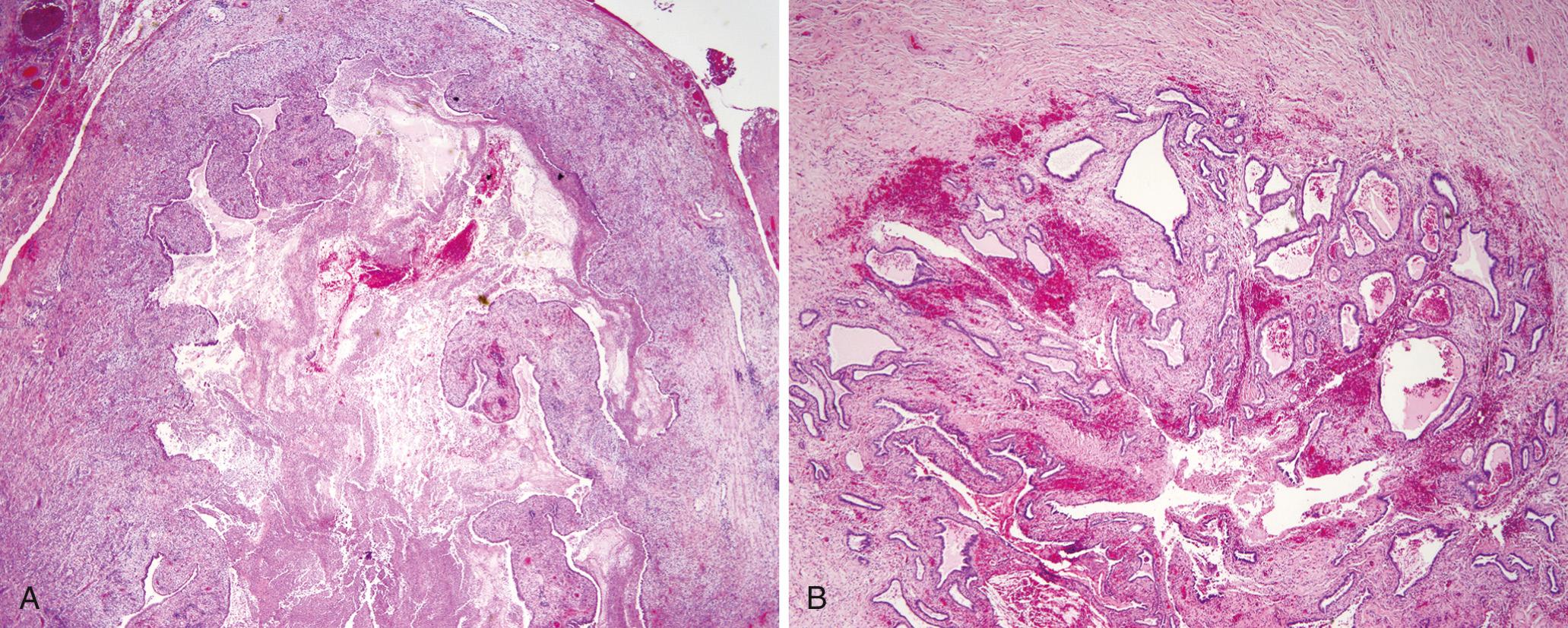
The acute complications of PID include peritonitis and bacteremia, which in turn may result in endocarditis, meningitis, and suppurative arthritis. The chronic sequelae of PID include infertility and tubal obstruction, ectopic pregnancy, pelvic pain, and intestinal obstruction due to adhesions between the bowel and pelvic organs. In the early stages, gonococcal infections are usually readily controlled with antibiotics, although penicillin-resistant strains have emerged. Infections that become walled off in tubo-ovarian abscesses are difficult to eradicate with antibiotics, and it sometimes becomes necessary to remove the organs surgically. Postabortion and postpartum PIDs may also be amenable to treatment with antibiotics, but are far more difficult to control because of the broad spectrum of pathogens that may be involved.
Diseases of the vulva in the aggregate constitute only a small fraction of gynecologic practice. Many inflammatory diseases that affect skin elsewhere on the body also occur on the vulva, such as psoriasis, eczema, and allergic dermatitis. Because it is constantly exposed to secretions and moisture, the vulva is more prone to superficial infections than skin elsewhere on the body. Nonspecific vulvitis is particularly likely to occur in the setting of immunosuppression. Most skin cysts (epidermal inclusion cysts) and skin tumors such as squamous cell carcinoma, basal cell carcinoma, and melanoma can also occur in the vulva. Here we discuss vulvar disorders that are relatively specific and common, including Bartholin cyst, non-neoplastic epithelial disorders, benign exophytic lesions, and tumors of the vulva.
Infection of the Bartholin gland produces an acute inflammation (adenitis) and may result in an abscess. Bartholin duct cysts are relatively common, occur at all ages, and result from obstruction of the duct by an inflammatory process. These cysts are usually lined by transitional or squamous epithelium. They may become large, up to 3 to 5 cm in diameter, and produce pain and local discomfort. Bartholin duct cysts are either excised or opened permanently (marsupialization).
Leukoplakia is a descriptive clinical term for opaque, white, plaquelike epithelial thickening that may produce pruritus and scaling. Leukoplakia (literally, white plaques ) may be caused by a variety of benign, premalignant, or malignant disorders, including the following:
Inflammatory dermatoses (e.g., psoriasis, chronic dermatitis)
Lichen sclerosus and squamous cell hyperplasia
Neoplasias, such as vulvar intraepithelial neoplasia (VIN), Paget disease, and invasive carcinoma
Inflammatory dermatoses associated with leukoplakia are described in Chapter 25 , while neoplastic disorders are discussed later in this chapter. Here the major non-neoplastic causes of leukoplakia—lichen sclerosis and squamous cell hyperplasia—are briefly discussed.
Lichen sclerosis presents as smooth, white plaques or macules that in time may enlarge and coalesce, producing a surface that resembles porcelain or parchment. When the entire vulva is affected, the labia become atrophic and agglutinated, and the vaginal orifice constricts. Histologically, the lesion is characterized by marked thinning of the epidermis ( Fig. 22.5A ), degeneration of the basal epithelial cells, excessive keratinization (hyperkeratosis), sclerotic changes of the superficial dermis, and a bandlike lymphocytic infiltrate in the underlying dermis. The disease occurs in all age groups but is most common in postmenopausal women. It may also be encountered elsewhere on the skin. Its pathogenesis is uncertain, but the presence of activated T cells in the subepithelial inflammatory infiltrate and the increased frequency of autoimmune disorders in affected women suggest that an autoimmune reaction is involved. Although lichen sclerosus is not itself a premalignant lesion, women with symptomatic lichen sclerosus have a slightly increased chance of developing squamous cell carcinoma of the vulva.
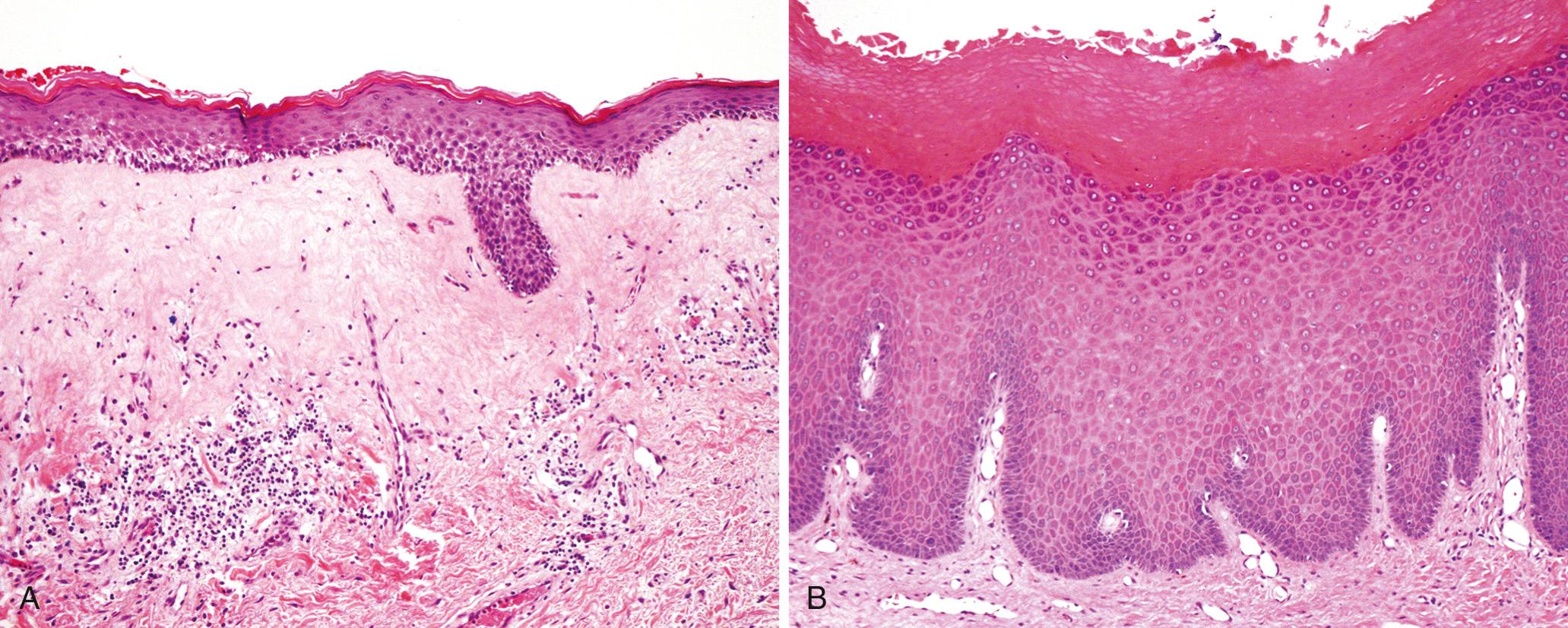
Previously called hyperplastic dystrophy or lichen simplex chronicus, squamous cell hyperplasia is a nonspecific condition resulting from rubbing or scratching of the skin to relieve pruritus. Clinically it presents as leukoplakia, and histologic examination reveals thickening of the epidermis (acanthosis) and hyperkeratosis (see Fig. 22.5B ). Lymphocytic infiltration of the dermis is sometimes present. The hyperplastic epithelium may show mitotic activity but lacks cellular atypia. While squamous cell hyperplasia is not considered premalignant, it is sometimes present at the margins of vulvar cancers.
Benign raised (exophytic) or wartlike lesions of the vulva may be caused by infection or may be reactive conditions of unknown etiology. Condyloma acuminatum, a papillomavirus-induced lesion, also called a genital wart, and syphilitic condyloma latum (described in Chapter 21 ) are consequences of sexually transmitted infections. Vulvar fibroepithelial polyps, or skin tags, are similar to skin tags occurring elsewhere on the skin. Vulvar squamous papillomas are benign exophytic proliferations covered by nonkeratinized squamous epithelium that develop on vulvar surfaces; they may be single or numerous (vulvar papillomatosis). The etiology of fibroepithelial polyps and squamous papillomas is unknown.
Condylomata acuminata are benign genital warts caused by low-risk HPV, mainly types 6 and 11. They may be solitary, but are more frequently multifocal, and they may involve vulvar, perineal, and perianal regions as well as the vagina and, less commonly, the cervix. The lesions are identical to those found on the penis and around the anus in males ( Chapter 21 ). On histologic examination, they consist of papillary, exophytic, treelike cores of stroma covered by thickened squamous epithelium ( Fig. 22.6A ). The surface epithelium shows characteristic viral cytopathic changes referred to as koilocytic atypia (see Fig. 22.6B ), which manifest as nuclear enlargement, hyperchromasia, and a cytoplasmic perinuclear halo (see the Cervix section later in this chapter). Condylomata acuminata are not precancerous lesions. HPV vaccines (described later) provide excellent protection against infection by low-risk HPV and genital warts.
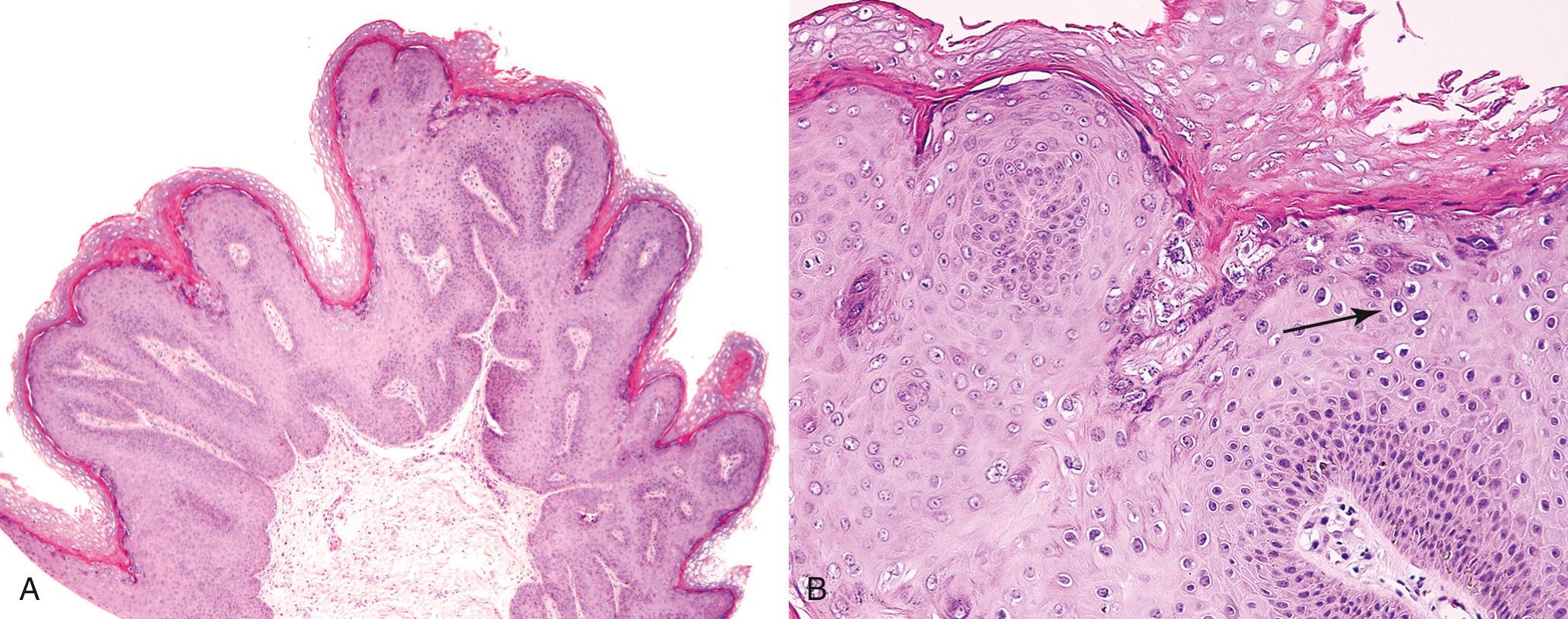
Carcinoma of the vulva is an uncommon malignant neoplasm (approximately one-eighth as frequent as cervical cancer) representing about 3% of all genital cancers in the female; approximately two-thirds occur in women older than 60 years of age. Squamous cell carcinoma is the most common histologic type of vulvar cancer. In terms of etiology, pathogenesis, and histologic features, vulvar squamous cell carcinomas are divided into two groups:
Basaloid and warty carcinomas are related to infection with high-risk HPVs, most commonly HPV-16. These are less common (30% of cases) and occur in younger women (average 60 years of age).
Keratinizing squamous cell carcinomas are unrelated to HPV infection. These are more common (70% of cases) and occur in older women (average 75 years of age).
Basaloid and warty carcinomas develop from an in situ precursor lesion called classic vulvar intraepithelial neoplasia (VIN). This form of VIN occurs mainly in reproductive age women and includes lesions formerly designated as carcinoma in situ or Bowen disease. The risk factors for VIN are the same as those associated with cervical squamous intraepithelial lesions (e.g., young age at first intercourse, multiple sexual partners, male partner with multiple sexual partners), as both are related to HPV infection. VIN is frequently multicentric, and 10% to 30% of patients with VIN also have vaginal or cervical HPV-related lesions. Spontaneous regression of classic VIN has been reported, usually in younger women. The risk of progression to invasive carcinoma is higher in women who are older than 45 years of age or who are immunosuppressed.
Keratinizing squamous cell carcinoma occurs most often in individuals with long-standing lichen sclerosus or squamous cell hyperplasia and is not related to HPV. It arises from a precursor lesion referred to as differentiated vulvar intraepithelial neoplasia (differentiated VIN). It is postulated that chronic epithelial irritation in lichen sclerosus or squamous cell hyperplasia may contribute to a gradual evolution to the malignant phenotype, presumably through acquisition of driver mutations in oncogenes and tumor suppressor genes. In line with this idea, some investigators have reported a high frequency of TP53 mutations in differentiated VIN.
The lesions of classic VIN may be discrete and white (hyperkeratotic) or slightly raised and pigmented. Microscopically, it is characterized by epidermal thickening, nuclear atypia, increased mitoses, and lack of cellular maturation ( Fig. 22.7A ), features analogous to those seen in cervical squamous intraepithelial lesions (SIL, see the Cervix section later in this chapter). Invasive carcinomas that arise from classic VIN may be exophytic or indurated with central ulceration. On histologic examination, basaloid carcinoma (see Fig. 22.7B ) consists of nests and cords of small, tightly packed cells that lack maturation and resemble the basal layer of the normal epithelium. The tumor may have foci of central necrosis. By contrast, warty carcinoma is characterized by exophytic, papillary architecture and prominent koilocytic atypia.
Differentiated VIN is characterized by marked atypia of the basal layer of the squamous epithelium and normal-appearing differentiation of the more superficial layers ( Fig. 22.8A ). Invasive keratinizing squamous cell carcinomas that arise in differentiated VIN contain nests and tongues of malignant squamous epithelium with prominent central keratin pearls (see Fig. 22.8B ).
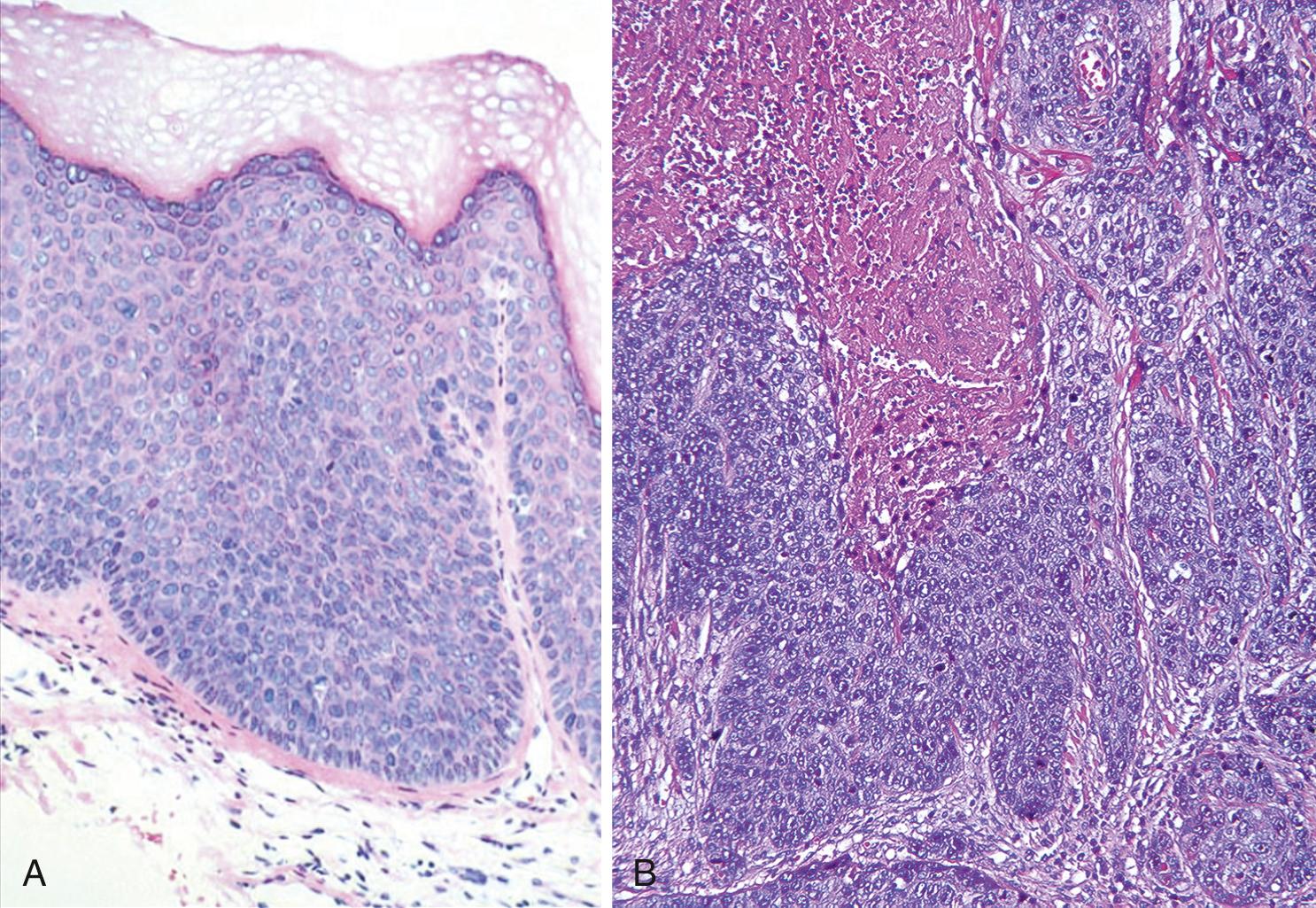
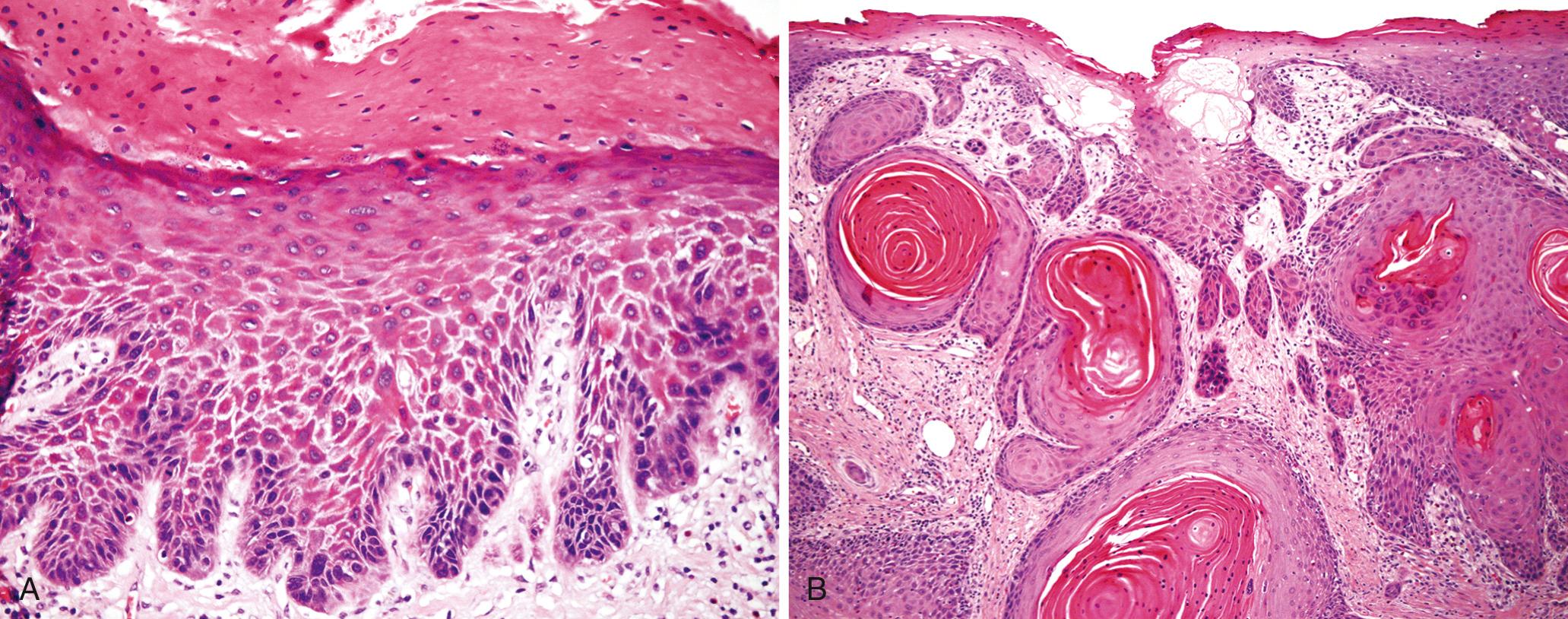
The risk of cancer development in VIN depends on duration and extent of disease, and the immune status of the patient. Invasive carcinomas associated with lichen sclerosus, squamous cell hyperplasia, and differentiated VIN may develop in an insidious fashion and may be misinterpreted as dermatitis or leukoplakia for long periods. Once invasive cancer develops, the risk of metastatic spread is determined by the size of tumor, the depth of invasion, and whether there is lymphatic invasion. The initial spread is to inguinal, pelvic, iliac, and periaortic lymph nodes. Ultimately, hematogenous dissemination to the lungs, liver, and other internal organs may occur. Patients with lesions less than 2 cm in diameter have a 90% 5-year survival rate after treatment with vulvectomy and lymphadenectomy; however, larger lesions with lymph node involvement have a poor prognosis.
Like the breast, the vulva contains modified apocrine sweat glands. Presumably because of these “breastlike” features, the vulva may be involved by two tumors with counterparts in the breast, papillary hidradenoma and extramammary Paget disease.
Papillary hidradenoma presents as a sharply circumscribed nodule, most commonly on the labia majora or interlabial folds, and may be confused clinically with carcinoma because of its tendency to ulcerate. Its histologic appearance is identical to that of intraductal papilloma of the breast and consists of papillary projections covered by two cell layers, an upper layer of columnar secretory cells and a deeper layer of flattened myoepithelial cells. These myoepithelial elements are characteristic of sweat glands and sweat gland tumors ( Fig. 22.9 ).
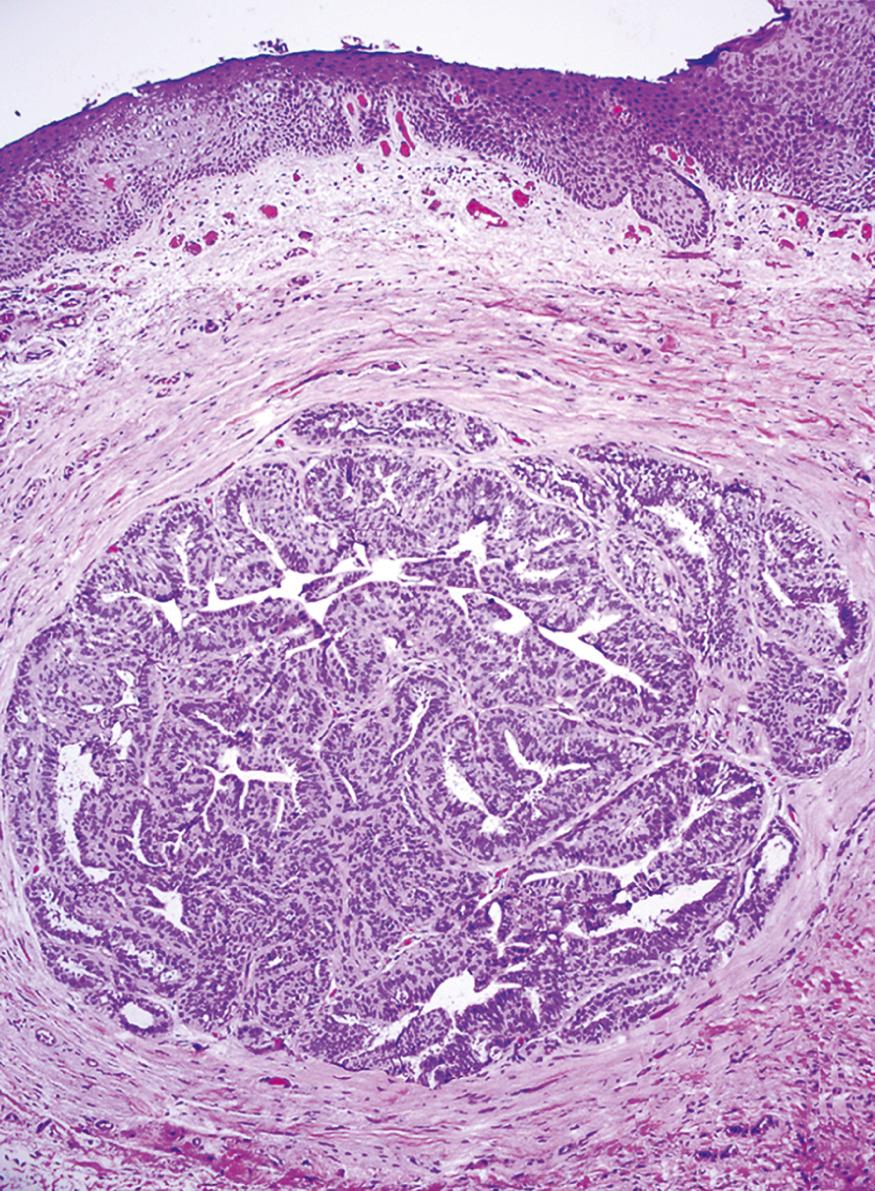
This curious and rare lesion of the vulva is similar in its manifestations to Paget disease of the breast ( Chapter 23 ). In the vulva, it presents as a pruritic, red, crusted, maplike area, usually on the labia majora.
Paget disease is a distinctive intraepithelial proliferation of malignant cells. Paget cells are larger than surrounding keratinocytes and are seen singly or in small clusters within the epidermis ( Fig. 22.10A ). The cells have pale cytoplasm containing mucopolysaccharide that stains with periodic acid–Schiff (PAS), Alcian blue, or mucicarmine stains. In addition, unlike squamous epithelium, the cells express cytokeratin 7 (see Fig. 22.10B ). Ultrastructurally, Paget cells display apocrine, eccrine, and keratinocyte differentiation and presumably arise from multipotent cells found within the mammary gland–like ducts of the vulvar skin.
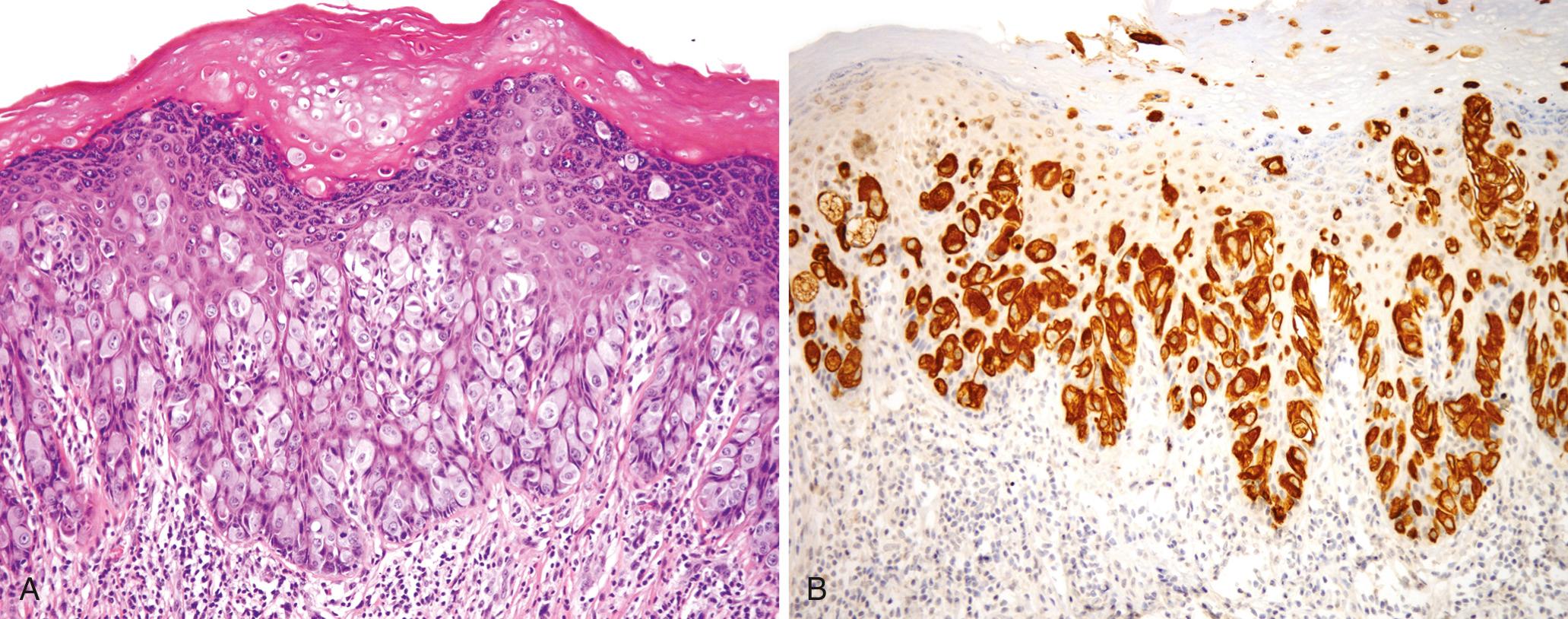
In contrast to Paget disease of the nipple, in which 100% of patients have an underlying ductal breast carcinoma, vulvar Paget is typically not associated with underlying cancer and is confined to the vulvar epidermis. Treatment consists of wide local excision, which is necessary because Paget cells spread laterally within the epidermis and may be present beyond the confines of the grossly visible lesion. Intra-epidermal Paget disease may persist for many years or even decades without invasion or metastases. In the rare instances when invasion develops, the prognosis is poor.
Approximately 30% of vulvar cancers are caused by infection with high-risk HPVs, principally HPV-16. These cancers develop from an in situ lesion termed classic vulvar intraepithelial neoplasia (classic VIN).
Most vulvar cancers (70%) are not related to HPV and develop in a background of lichen sclerosus or squamous cell hyperplasia from the premalignant lesion called differentiated vulvar intraepithelial neoplasia (differentiated VIN).
The vagina is a portion of the female genital tract that is remarkably resistant to diseases that affect nearby structures. For example, in the adult, inflammation that begins in the vulva and perivulvar structures often spreads to the cervix without significant involvement of the vagina. Primary lesions of the vagina are rare, the most serious being vaginal squamous cell carcinoma; they are discussed only briefly here.
Septate, or double, vagina is an uncommon anomaly that arises from a failure of müllerian duct fusion and is accompanied by a double uterus (uterus didelphys). These and other anomalies of the external genitalia may be the manifestations of genetic syndromes, in utero exposure to diethylstilbestrol (DES, used to prevent threatened abortions in the 1940s to 1960s), or other unknown factors that perturb reciprocal epithelial-stromal signaling during fetal development.
During embryonal development, the vagina is initially covered by columnar, endocervical-type epithelium. This is normally replaced by squamous epithelium advancing upward from the urogenital sinus. Small patches of residual glandular epithelium may persist into adult life; such areas are recognized as vaginal adenosis, which on examination presents as red, granular areas that stand out from the surrounding normal pale-pink vaginal mucosa. Microscopically, adenosis consists of columnar mucinous epithelium indistinguishable from endocervix. Adenosis is found in only a small percentage of adult women, but has been reported in 35% to 90% of women exposed to DES in utero. Rare cases of clear cell carcinoma arising in DES-related adenosis were recorded in teenagers and young adult women in the 1970s and 1980s, resulting in discontinuation of DES treatment.
Gartner duct cysts are relatively common lesions found along the lateral walls of the vagina that are derived from wolffian (mesonephric) duct rests. They consist of 1- to 2-cm fluid-filled submucosal cysts. Other cysts, including mucus cysts, which occur in the proximal vagina, are derived from müllerian epithelium. Another müllerian-derived lesion, endometriosis (described later), may occur in the vagina and clinically simulate a neoplasm.
Most benign tumors of the vagina occur in reproductive-age women and include stromal tumors (stromal polyps), leiomyomas, and hemangiomas. The most common malignant tumor to involve the vagina is carcinoma spreading from the cervix, followed by primary squamous cell carcinoma of the vagina. Infants may develop a unique, rare malignancy—embryonal rhabdomyosarcoma (sarcoma botryoides).
Virtually all primary carcinomas of the vagina are squamous cell carcinomas associated with high-risk HPV infection. Vaginal carcinoma is extremely uncommon (about 0.6 per 100,000 women yearly) and accounts for about 1% of malignant neoplasms in the female genital tract. The greatest risk factor is a previous carcinoma of the cervix or vulva; 1% to 2% of women with an invasive cervical carcinoma eventually develop a vaginal squamous cell carcinoma. Squamous cell carcinoma of the vagina arises from a premalignant lesion, vaginal intraepithelial neoplasia, analogous to cervical squamous intraepithelial lesion (SIL; see the Cervix section later in this chapter). Most often the invasive tumor affects the upper vagina, particularly the posterior wall at the junction with the ectocervix. The lesions in the lower two-thirds of the vagina metastasize to the inguinal nodes, whereas lesions in the upper vagina tend to spread to regional iliac nodes.
Also called sarcoma botryoides, this uncommon vaginal tumor composed of malignant embryonal rhabdomyoblasts is most frequently found in infants and children younger than 5 years of age. These tumors tend to grow as polypoid, rounded, bulky masses that have the appearance and consistency of grapelike clusters (hence the designation botryoides, or grapelike) ( Fig. 22.11 ). The tumor cells are small and have oval nuclei, with small protrusions of cytoplasm from one end, resembling a tennis racket. Rarely, striations (indicative of muscle differentiation) can be seen within the cytoplasm. Beneath the vaginal epithelium, the tumor cells are crowded in a so-called cambium layer, but in the deep regions they lie within a loose edematous fibromyxomatous stroma that may contain many inflammatory cells. Such lesions can be mistaken for benign inflammatory polyps. The tumors tend to invade locally and cause death by penetration into the peritoneal cavity or by obstruction of the urinary tract. Conservative surgery coupled with chemotherapy offer the best hope, particularly in cases diagnosed sufficiently early.
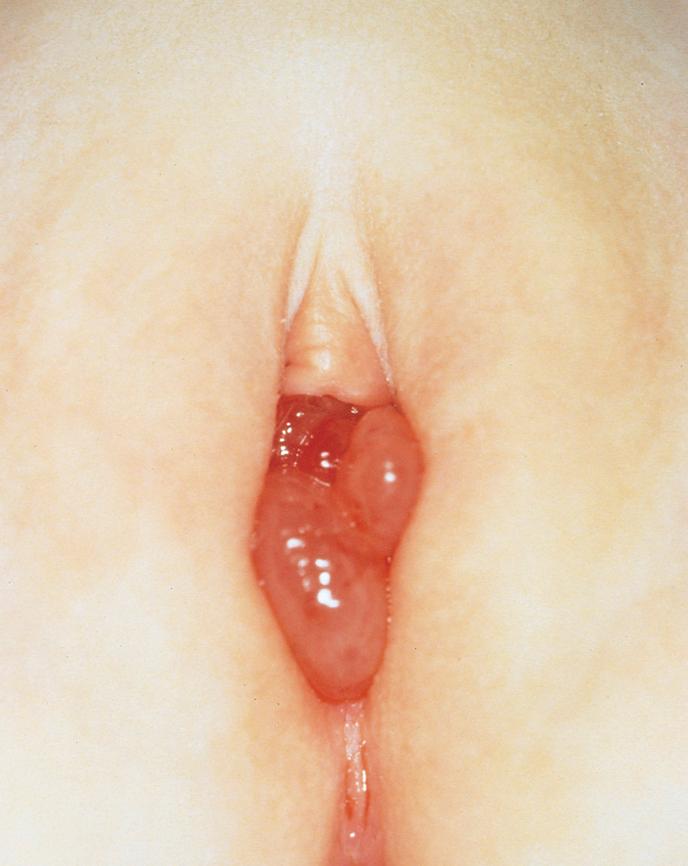
Anatomically the cervix consists of the external vaginal portio (ectocervix) and the endocervical canal. The ectocervix is visible on vaginal examination and is covered by a mature squamous epithelium that is continuous with the vaginal wall. The squamous epithelium converges centrally at a small opening termed the external os that leads to the endocervical canal. The endocervix is lined by columnar, mucus-secreting epithelium. The point where the squamous and the columnar epithelium meet is referred to as the squamocolumnar junction ( Fig. 22.12 ). The position of the junction is variable and changes with age and hormonal influence, but in general the junction moves upward into the endocervical canal with time. The replacement of the glandular epithelium by advancing squamous epithelium is a process called squamous metaplasia. The area of the cervix where the columnar epithelium coexists with the squamous epithelium is termed the “transformation zone.” The unique epithelial environment of the cervix renders it highly susceptible to infection with HPV, the main cause of cervical cancer. Immature squamous cells in the transformation zone are most susceptible to HPV infection, and as a result this is where the majority of cervical precursor lesions and cervical cancers develop.
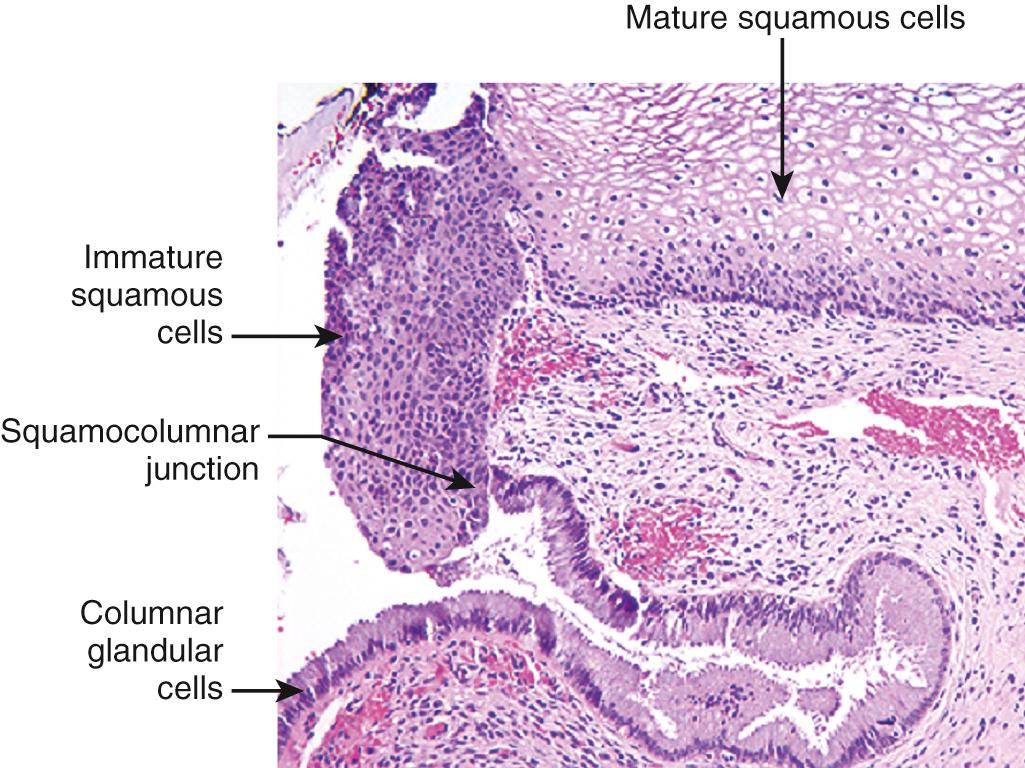
At the onset of menarche, the production of estrogens by the ovary stimulates maturation of the cervical and vaginal squamous mucosa and formation of intracellular glycogen vacuoles in the squamous cells. As these cells are shed, the glycogen provides a substrate for various endogenous vaginal aerobes and anaerobes, but particularly lactobacilli, which are the dominant microbial species in the normal vagina. Lactobacilli produce lactic acid, which maintains the vaginal pH below 4.5, suppressing the growth of other saprophytic and pathogenic organisms. In addition, at low pH, lactobacilli produce bacteriotoxic hydrogen peroxide (H 2 O 2 ). If the pH becomes alkaline due to bleeding, sexual intercourse, or vaginal douching, H 2 O 2 production by lactobacilli decreases. Antibiotic therapy that suppresses lactobacilli can also cause the pH to rise. In each of these settings, the altered vaginal environment promotes the overgrowth of other microorganisms, which may result in cervicitis or vaginitis. Some degree of cervical inflammation may be found in virtually all women, and it is usually of little clinical consequence. However, infections by gonococci, chlamydiae, mycoplasmas, and HSV may produce significant acute or chronic cervicitis and are important to identify due to their association with upper genital tract disease, complications during pregnancy, and sexual transmission. Marked cervical inflammation produces reparative and reactive changes of the epithelium and shedding of atypical-appearing squamous cells, and therefore may cause an abnormal Pap test result.
Endocervical polyps are common benign exophytic growths that arise within the endocervical canal. They vary from small, sessile “bumps” to large polypoid masses that may protrude through the cervical os. Histologically, they are composed of a fibrous stroma covered by mucus-secreting endocervical glands, often accompanied by inflammation ( Fig. 22.13 ). Their main significance is that they may be the source of irregular vaginal “spotting” or bleeding that arouses suspicion of some more ominous lesion. Simple curettage or surgical excision is curative.
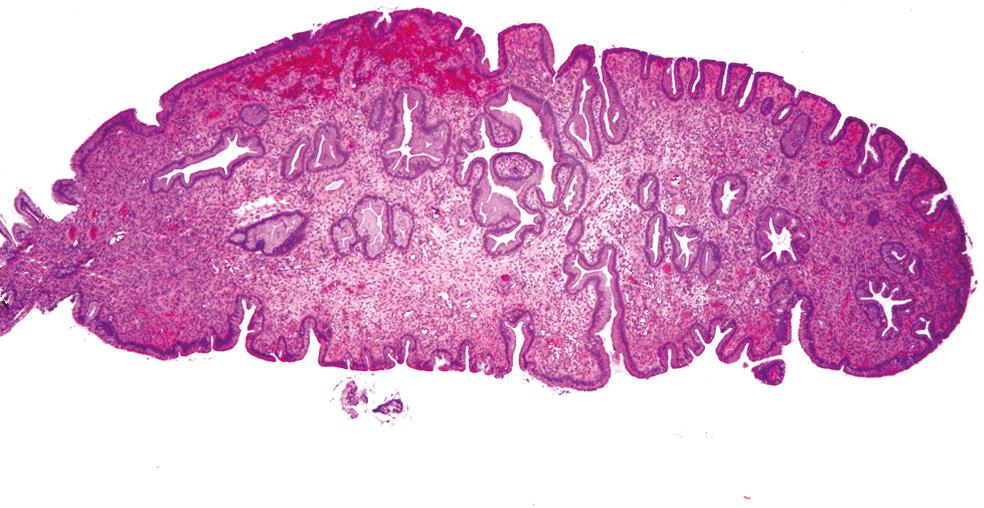
Worldwide, cervical carcinoma is the fourth most common cancer in women, with an estimated 570,000 new cases in 2018, of which more than one-half will prove fatal. In the United States, it was estimated in 2019 that 13,179 women would be diagnosed with cervical cancer and that 4250 women would die of the disease. Fifty years ago, carcinoma of the cervix was the leading cause of cancer death in women in the United States, but the death rate has declined by 75% to its present rank as the thirteenth cause of cancer mortality. No form of cancer better documents the remarkable benefits of effective screening, early diagnosis, and curative therapy than does cancer of the cervix. Most credit for these dramatic gains belongs to the effectiveness of the Pap test in detecting cervical precursor lesions, some of which would have progressed to cancer if not treated; in addition, the Pap test can also detect low-stage, highly curable cancers. The accessibility of the cervix to Pap testing and visual examination (colposcopy) as well as the slow progression from precursor lesions to invasive carcinoma (typically over the course of decades) provides ample time for screening, detection, and preventive treatment.
High-risk HPVs are by far the most important factor in the development of cervical cancer. HPVs are DNA viruses that are grouped into those of high and low oncogenic risk based on their genotypes. There are 15 high-risk HPVs that are currently identified, but HPV-16 alone accounts for almost 60% of cervical cancer cases, and HPV-18 accounts for another 10% of cases; other HPV types contribute to less than 5% of cases, individually. High-risk HPVs are also implicated in squamous cell carcinomas arising at many other sites, including the vagina, vulva, penis, anus, tonsil, and other oropharyngeal locations. As noted earlier, low oncogenic risk HPVs are the cause of sexually transmitted vulvar, perineal, and perianal warts (condyloma acuminatum).
Genital HPV infections are extremely common; most of them are asymptomatic, do not cause any tissue changes, and therefore are not detected on Pap test. The prevalence of HPV in cervical smears in women with normal Pap test results peaks between 20 and 24 years of age, around the onset of sexual activity, and subsequently declines as protective immunity is established and women enter into monogamous relationships. Most HPV infections are transient; overall, 50% of HPV infections are cleared within 8 months, and 90% of infections are cleared within 2 years. The duration of the infection is related to HPV type, as infections with high-risk HPVs take longer to clear on average than infections with low-risk HPVs (13 months vs. 8 months, respectively). Persistent infection increases the risk of the development of cervical precursor lesions and subsequent carcinoma.
Productive, persistent HPV infection requires viral entry into immature basal epithelial cells. As a result, surfaces covered with mature, intact squamous epithelium, such as the ectocervix, vagina, vulva, penis, and oropharynx, are normally resistant to HPV infection. Sites in the female genital tract that are susceptible to infection include areas of squamous epithelial trauma and repair, where the virus may access basal cells, and the immature metaplastic squamous cells that are present at the squamocolumnar junction of the cervix (see Fig. 22.12 ). The cervix, with its relatively large areas of immature squamous metaplastic epithelium, is particularly vulnerable to HPV infection. Other sites in the body that are vulnerable to HPV infection include the squamocolumnar junction of the anus and the squamous cells of oropharyngeal tonsillar crypts, both relatively common sites of HPV-associated cancers in individuals who practice anal or oral sex, respectively.
The ability of HPV to act as a carcinogen depends on the viral E6 and E7 proteins, which interfere with the activity of the key tumor suppressor proteins, p53 and RB, respectively. Although HPV infects immature squamous cells, viral replication occurs in maturing squamous cells. Normally, these more mature cells are arrested in the G 1 phase of the cell cycle, but they continue to actively progress through the cell cycle when infected with HPV, which uses the host cell DNA synthesis machinery to replicate its own genome. As you will recall from Chapter 7 , viral E7 protein binds the hypophosphorylated (active) form of RB and promotes its degradation via the proteasome pathway, and also binds and inhibits p21 and p27, two important cyclin-dependent kinase inhibitors. Removal of these controls not only enhances cell cycle progression, but also impairs the ability of cells to repair DNA damage. The DNA repair defect in infected cells is exacerbated by E6 proteins encoded by high-risk HPV subtypes, which bind p53 and promote its degradation by the proteasome. In addition, E6 up-regulates the expression of telomerase, which leads to cellular immortalization. The net effect is increased proliferation of cells that are prone to acquire additional mutations that may lead to cancer development. By contrast to high-risk HPVs, the E7 proteins of low-risk HPVs bind RB with lower affinity, while the E6 proteins of low-risk HPVs fail to bind p53 altogether and instead appear to dysregulate growth and survival by interfering with the Notch signaling pathway.
Another factor that contributes to malignant transformation by HPV is the physical state of the virus. The viral DNA is integrated into the host cell genome in most cancers. This configuration increases the expression of E6 and E7 genes, and may also dysregulate oncogenes near the sites of viral insertion, such as MYC . By contrast, viral DNA is extrachromosomal (episomal) in precursor lesions associated with high-risk HPVs and in condylomata associated with low-risk HPVs.
Even though HPV is firmly established as the major cause of cervical cancer, it is worth remembering that although a high percentage of young women are infected with one or more HPV types during their reproductive years, only a few develop cancer. Thus, other factors, such as exposure to co-carcinogens and host immune status, influence whether an HPV infection regresses or persists and eventually leads to cancer.
The classification of cervical precursor lesions has evolved over time, and the terms from the various classification systems are used interchangeably. Hence a brief review of the terminology is warranted. The oldest classification system grouped lesions as having mild dysplasia on one end and severe dysplasia/carcinoma in situ on the other. This was followed by the cervical intraepithelial neoplasia (CIN) classification, with mild dysplasia termed CIN I, moderate dysplasia termed CIN II, and severe dysplasia termed CIN III . Because the decision with regard to patient management is two-tiered (observation vs. surgical treatment), the three-tier classification system has been recently simplified to a two-tiered system, with CIN I renamed low-grade squamous intraepithelial lesion (LSIL) and CIN II and CIN III combined into one category referred to as high-grade squamous intraepithelial lesion (HSIL) ( Table 22.1 ).
| Dysplasia/Carcinoma in situ | CIN | SIL, Current Classification |
|---|---|---|
| Mild dysplasia | CIN I | Low-grade SIL (LSIL) |
| Moderate dysplasia | CIN II | High-grade SIL (HSIL) |
| Severe dysplasia | CIN III | High-grade SIL (HSIL) |
| Carcinoma in situ | CIN III | High-grade SIL (HSIL) |
LSIL does not progress directly to invasive carcinoma, and, in fact, most cases regress spontaneously; only a small percentage progress to HSIL. LSIL represents a productive HPV infection in which there is a high level of viral replication, but only mild alterations in the growth of host cells. For these reasons, LSIL is not treated like a premalignant lesion. LSIL is approximately ten times more common than HSIL.
By contrast to LSIL, HSIL is considered to be at high risk for progression to carcinoma. In HSIL, there is a progressive deregulation of the cell cycle by HPV, which results in increased cellular proliferation, decreased or arrested epithelial maturation, and a lower rate of viral replication as compared with LSIL. Derangement of the cell cycle in HSIL may become irreversible and lead to a fully transformed malignant phenotype.
The diagnosis of SIL is based on identification of nuclear atypia characterized by nuclear enlargement, hyperchromasia (dark staining), coarse chromatin granules, and variation in nuclear size and shape ( Fig. 22.14 ). The nuclear changes are often accompanied by cytoplasmic “halos.” At an ultrastructural level, these “halos” consist of perinuclear vacuoles, a cytopathic change created in part by an HPV-encoded protein E5 that localizes to the membranes of the endoplasmic reticulum. Nuclear alterations associated with perinuclear halos are termed koilocytic atypia. The grading of SIL into low or high grade is based on expansion of the immature cell layer from its normal, basal location. If the immature squamous cells are confined to the lower one-third of the epithelium, the lesion is called LSIL; if they expand to the upper two-thirds of the epithelial thickness, it is called HSIL.
The histologic features of LSIL correlate with HPV replication and changes in host cell growth and gene expression ( Fig. 22.15 ). The highest viral loads (assessed by in situ hybridization for HPV DNA; see Fig. 22.15B ) are found in maturing keratinocytes in the upper half of the epithelium. HPV E6 and E7 proteins prevent cell cycle arrest. As a result, cells in the upper portion of the epithelium express markers of actively dividing cells, such as Ki-67 (see Fig. 22.15C ), that are normally confined to the basal layer of the epithelium. Disturbed growth regulation also leads to overexpression of p16, a cyclin-dependent kinase inhibitor (see Fig. 22.15D ). Both Ki-67 and p16 staining are highly correlated with HPV infection and are useful for confirmation of the diagnosis in equivocal cases of SIL.
![Figure 22.14, Spectrum of cervical intraepithelial neoplasia: normal squamous epithelium for comparison; low-grade squamous intraepithelial lesion (cervical intraepithelial neoplasia [CIN] I) with koilocytic atypia; high-grade squamous intraepithelial lesion (HSIL) (CIN II) with progressive atypia and expansion of the immature basal cells above the lower third of the epithelial thickness; HSIL (CIN III) with diffuse atypia, loss of maturation, and expansion of the immature basal cells to the epithelial surface. Figure 22.14, Spectrum of cervical intraepithelial neoplasia: normal squamous epithelium for comparison; low-grade squamous intraepithelial lesion (cervical intraepithelial neoplasia [CIN] I) with koilocytic atypia; high-grade squamous intraepithelial lesion (HSIL) (CIN II) with progressive atypia and expansion of the immature basal cells above the lower third of the epithelial thickness; HSIL (CIN III) with diffuse atypia, loss of maturation, and expansion of the immature basal cells to the epithelial surface.](https://storage.googleapis.com/dl.dentistrykey.com/clinical/TheFemaleGenitalTract/12_3s20B9780323531139000224.jpg)
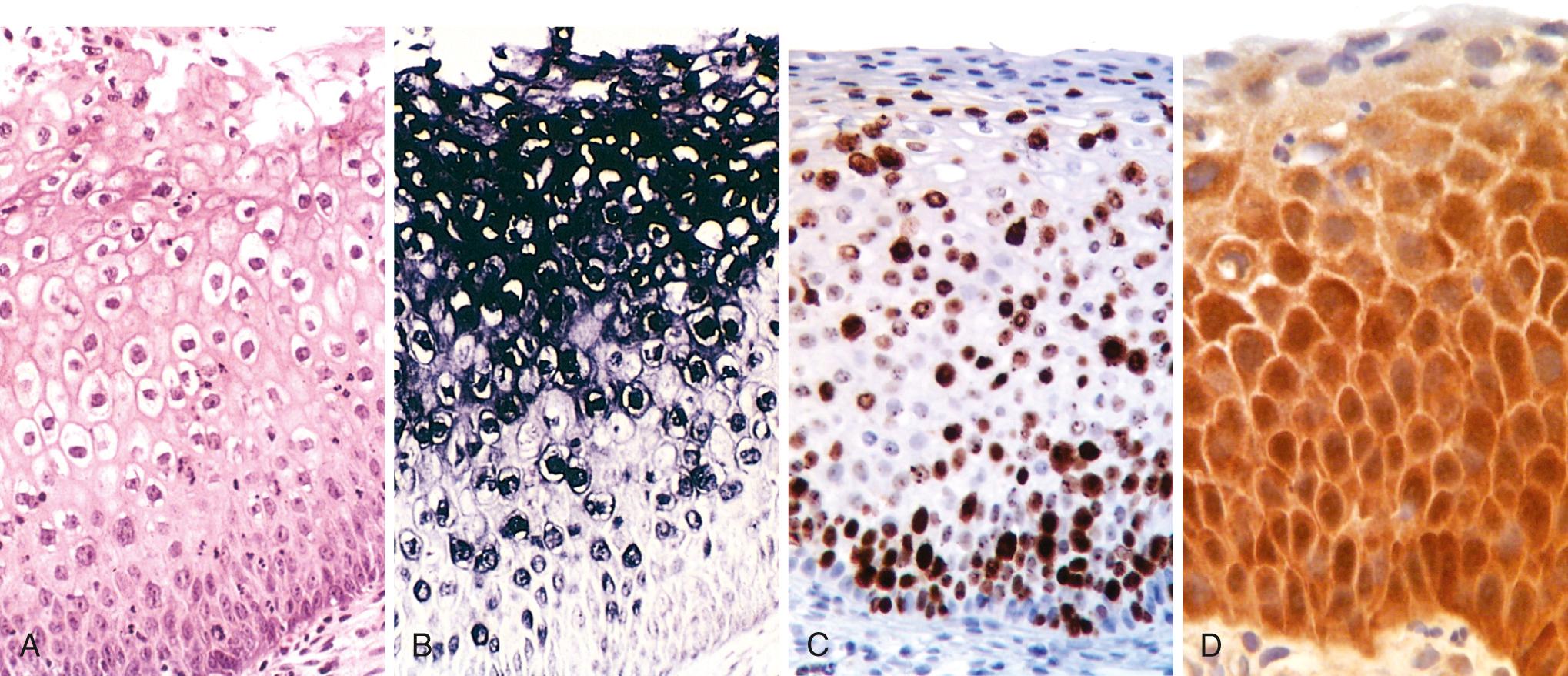
More than 80% of LSILs and 100% of HSILs are associated with high-risk HPVs, with HPV-16 being the most common HPV type in both lesions. Table 22.2 shows rates of regression and progression of SILs within a 2-year follow-up. Although the majority of HSILs develop from LSILs, approximately 20% of cases of HSIL develop de novo, independent of any preexisting LSIL. The rates of progression are by no means uniform, and although HPV type—especially HPV 16—is associated with increased risk, it is difficult to predict the outcome in an individual patient. These findings underscore that the risk of precursor lesions and cancer is conferred only in part by HPV type. Progression to invasive carcinoma, when it occurs, on average takes place over several decades.
| Lesion | Regress | Persist | Progress |
|---|---|---|---|
| LSIL | 60% | 30% | 10% to HSIL |
| HSIL | 30% | 60% | 10% to carcinoma a |
The average age of patients with invasive cervical carcinoma is between 45 and 50 years. Squamous cell carcinoma is the most common histologic subtype, accounting for approximately 80% of cases. The second most common tumor type is adenocarcinoma, which constitutes about 15% of cervical cancer cases and develops from a precursor lesion called adenocarcinoma in situ. Adenosquamous and neuroendocrine carcinomas are rare cervical tumors that account for the remaining 5% of cases. All of the aforementioned tumor types are caused by high-risk HPVs. The progression time from in situ to invasive adenosquamous and neuroendocrine carcinomas is shorter than in squamous cell carcinoma, and patients with these tumors often present with advanced disease and have a less favorable prognosis.
Invasive cervical carcinoma may manifest as fungating (exophytic) or infiltrative masses. Squamous cell carcinoma is composed of nests and tongues of malignant squamous epithelium, either keratinizing or nonkeratinizing, which invade the underlying cervical stroma ( Fig. 22.16A–B ). Adenocarcinoma is characterized by proliferation of glandular epithelium composed of malignant endocervical cells with large, hyperchromatic nuclei and relatively mucin-depleted cytoplasm, resulting in a dark appearance of the glands, as compared with the normal endocervical epithelium ( Fig. 22.17A–B ). Adenosquamous carcinoma is composed of intermixed malignant glandular and squamous epithelium. Neuroendocrine cervical carcinoma has an appearance similar to small cell carcinoma of the lung ( Chapter 15 ) but differs in being positive for high-risk HPVs.
Advanced cervical carcinoma spreads by direct extension to contiguous tissues, including paracervical soft tissue, urinary bladder, ureters (resulting in hydronephrosis), rectum, and vagina. Lymphovascular invasion results in local and distant lymph nodes metastases. Distant metastases may also be found in the liver, lungs, bone marrow, and other organs.
Cervical cancer is staged as follows:
Stage 0— Carcinoma in situ (CIN III, HSIL)
Stage I— Carcinoma confined to the cervix
Ia—Preclinical carcinoma, that is, diagnosed only by microscopy
Ia1—Stromal invasion no deeper than 3 mm and no wider than 7 mm (so-called superficially invasive squamous cell carcinoma)
Ia2—Maximum depth of invasion of stroma deeper than 3 mm and no deeper than 5 mm taken from base of epithelium; horizontal invasion no more than 7 mm
Ib—Histologically invasive carcinoma confined to the cervix and greater than stage Ia2
Stage II— Carcinoma extends beyond the cervix but not to the pelvic wall. Carcinoma involves the vagina but not the lower third.
Stage III— Carcinoma has extended to the pelvic wall. On rectal examination, there is no cancer-free space between the tumor and the pelvic wall. The tumor involves the lower third of the vagina.
Stage IV— Carcinoma has extended beyond the true pelvis or has involved the mucosa of the bladder or rectum. This stage also includes cancers with metastatic dissemination.
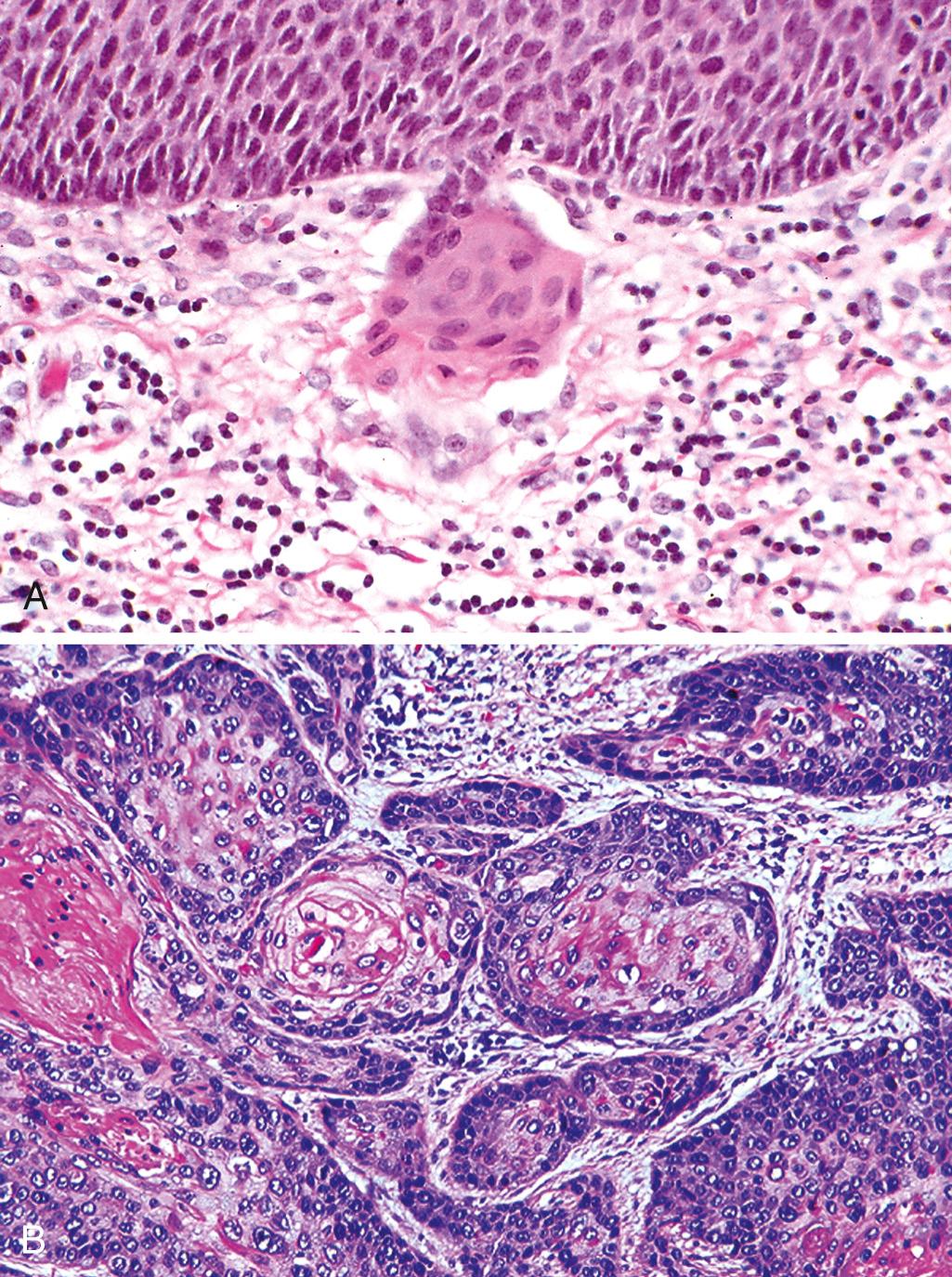

More than one-half of invasive cervical cancers are detected in women who did not participate in regular screening. While superficially invasive squamous cell carcinomas may be treated by cervical cone excision alone, most invasive cancers are managed by hysterectomy with lymph node dissection and, for advanced lesions, radiation and chemotherapy. The prognosis for invasive carcinomas depends on the stage of the cancer at diagnosis and to some degree on histologic subtype, with small-cell neuroendocrine tumors having a very poor prognosis. With current treatments, the 5-year survival rate is 100% for superficially invasive squamous cell carcinomas and less than 20% for tumors extending beyond the pelvis. Most patients with advanced cervical cancer die of the consequences of local tumor invasion (e.g., ureteral obstruction, pyelonephritis, and uremia) rather than distant metastases.
As is well known, cytologic cancer screening has significantly reduced mortality from cervical cancer. In countries where such screening is not widely practiced, cervical cancer continues to exact a high toll. The reason that cytologic screening is so effective in preventing cervical cancer is that most cancers arise from precursor lesions over the course of years. These lesions shed abnormal cells that can be detected on cytologic examination. Using a spatula or brush, the transformation zone of the cervix is circumferentially scraped and the cells are smeared or spun down onto a slide. Following fixation and staining with the Papanicolaou method, the smears are screened microscopically by eye or (increasingly) with automated image analysis systems. The cellular changes seen on the Pap test, illustrating the spectrum from LSIL to HSIL, are shown in Fig. 22.18 .
![Figure 22.18, The cytology of cervical intraepithelial neoplasia as seen on the Papanicolaou smear. The cytoplasmic staining of desquamated cells may be either red or blue. (A) Normal exfoliated superficial squamous cells. (B) Low-grade squamous intraepithelial lesion—koilocytes. (C) High-grade squamous intraepithelial lesion (HSIL; cervical intraepithelial neoplasia [CIN] II). (D) HSIL (CIN III). Note the reduction in cytoplasm and the increase in the nucleus-to-cytoplasm ratio, which occurs as the grade of the lesion increases. This reflects the progressive loss of cellular differentiation on the surface of the lesions from which these cells are exfoliated. Figure 22.18, The cytology of cervical intraepithelial neoplasia as seen on the Papanicolaou smear. The cytoplasmic staining of desquamated cells may be either red or blue. (A) Normal exfoliated superficial squamous cells. (B) Low-grade squamous intraepithelial lesion—koilocytes. (C) High-grade squamous intraepithelial lesion (HSIL; cervical intraepithelial neoplasia [CIN] II). (D) HSIL (CIN III). Note the reduction in cytoplasm and the increase in the nucleus-to-cytoplasm ratio, which occurs as the grade of the lesion increases. This reflects the progressive loss of cellular differentiation on the surface of the lesions from which these cells are exfoliated.](https://storage.googleapis.com/dl.dentistrykey.com/clinical/TheFemaleGenitalTract/16_3s20B9780323531139000224.jpg)
Testing for the presence of HPV DNA in the cervical scrape is a molecular method of cervical cancer screening. HPV testing has a higher sensitivity but lower specificity, as compared to the Pap test. HPV DNA testing may be added to cervical cytology for screening in women 30 years of age or older. HPV testing of women younger than 30 years of age is not recommended because of the high incidence of infection, and thus the particularly low specificity of HPV test results in this age group.
Cervical cancer screening and preventive measures are carried out in a stepwise fashion. Recommendations for the frequency of Pap screening vary, but in general the first smear should be at 21 years of age or within 3 years of onset of sexual activity, and thereafter every 3 years. After 30 years of age, women who have had normal cytology results and are negative for HPV may be screened every 5 years. Women who have a normal cytology result but test positive for high-risk HPV DNA should have cervical cytology repeated every 6 to 12 months.
When the result of a Pap test is abnormal, a colposcopic examination of the cervix and vagina is performed to identify the lesion. The mucosa is examined with a magnifying glass following application of acetic acid, which highlights abnormal epithelium as white spots (aceto-white areas). Abnormal appearing areas are biopsied. Women with biopsy-confirmed LSIL can be followed in a conservative fashion. Some gynecologists will perform local ablation (e.g., cryotherapy) of LSIL, particularly if there is concern about the reliability of patient follow-up. HSIL is treated with cervical conization (superficial excision).
An additional important aspect of cervical cancer prevention is vaccination against high-risk oncogenic HPV, which is now recommended for all girls and boys by 11 to 12 years of age, as well as young men and women up to 26 years of age. Two HPV vaccines are now FDA-licensed. Both provide nearly complete protection against high-risk oncogenic HPV types 16 and 18 (together accounting for approximately 70% of cervical cancers), and one also provides protection against additional five high oncogenic risk HPVs as well as two low oncogenic risk HPV types 6 and 11, which are responsible for genital warts. Vaccination is now recommended for boys as well as girls due to the role that males play in the spread of HPV to women and the toll that HPV-related anal and oropharyngeal cancers take in men. The vaccines offer protection for up to 10 years; longer follow-up studies are still pending. Because the HPV vaccines do not protect against all high-risk HPV types, current guidelines recommend that cervical cancer screening be continued as in the past.
Cervical LSIL is a productive HPV infection that usually regresses spontaneously but occasionally progresses to HSIL.
HSIL is characterized by progressive deregulation of the cell cycle and increasing cellular atypia. HSIL may progress to invasive carcinoma.
Almost all cervical precursor lesions and cervical carcinomas are caused by high-risk HPV types, most commonly HPV-16.
The uterus has two major components: the myometrium and the endometrium. The myometrium is composed of tightly interwoven bundles of smooth muscle that form the wall of the uterus. The internal cavity of the uterus is lined by the endometrium, which is composed of glands embedded in a cellular stroma. The uterus is affected by a variety of disorders, the most common of which results from endocrine imbalances, complications of pregnancy, and neoplastic proliferation.
The endometrium undergoes dynamic physiologic and morphologic changes during the menstrual cycle in response to sex steroid hormones coordinately produced in the ovary. The ovary is influenced by hormones produced by the pituitary gland due to signals from the hypothalamus. Together, hypothalamic, pituitary, and ovarian factors and their interactions regulate maturation of ovarian follicles, ovulation, and menstruation.
The histologic appearance of the endometrium may be used to assess hormonal status, document ovulation, and determine causes of endometrial bleeding and infertility ( Fig. 22.19 ). Progression through a normal menstrual cycle is correlated with the following histologic features:
The cycle commences with menses, during which the superficial portion of the endometrium, referred to as the functionalis, is shed.
The proliferative phase is marked by rapid growth of glands and stroma arising from the deeper portion of the endometrium (basalis). During the proliferative phase, the glands are straight, tubular structures lined by regular, tall, pseudostratified columnar cells. Mitotic figures are numerous, and there is no evidence of mucus secretion or vacuolation. The endometrial stroma is composed of spindle cells with scant cytoplasm that are also actively proliferating (see Fig. 22.19A ).
At ovulation, endometrial proliferation ceases and differentiation commences in response to the effects of progesterone made by the corpus luteum in the ovary.
Postovulation is initially marked by the appearance of secretory vacuoles beneath the nuclei in the glandular epithelium (see Fig. 22.19B ). Secretory activity is most prominent during the third week of the menstrual cycle, when the basal vacuoles progressively move to the apical surface. By the fourth week, the glands are tortuous, producing a serrated appearance. This serrated or “sawtooth” appearance is accentuated by secretory exhaustion and shrinkage of the glands.
Stromal changes in the late secretory phase, due predominantly to progesterone, are the most significant features. Prominent spiral arterioles appear accompanied by an increase in ground substance and edema between the stromal cells followed by stromal cell hypertrophy, increased cytoplasmic eosinophilia (predecidual change), and a resurgence of stromal mitoses (see Fig. 22.19C ). Predecidual changes spread throughout the functionalis and are accompanied by a sparse infiltrate of neutrophils and lymphocytes, which in this context are considered normal.
With the dissolution of the corpus luteum and the subsequent drop in progesterone levels, the functionalis degenerates and bleeding into the stroma occurs, followed by stromal breakdown and onset of the next menstrual cycle (see Fig. 22.19D ).
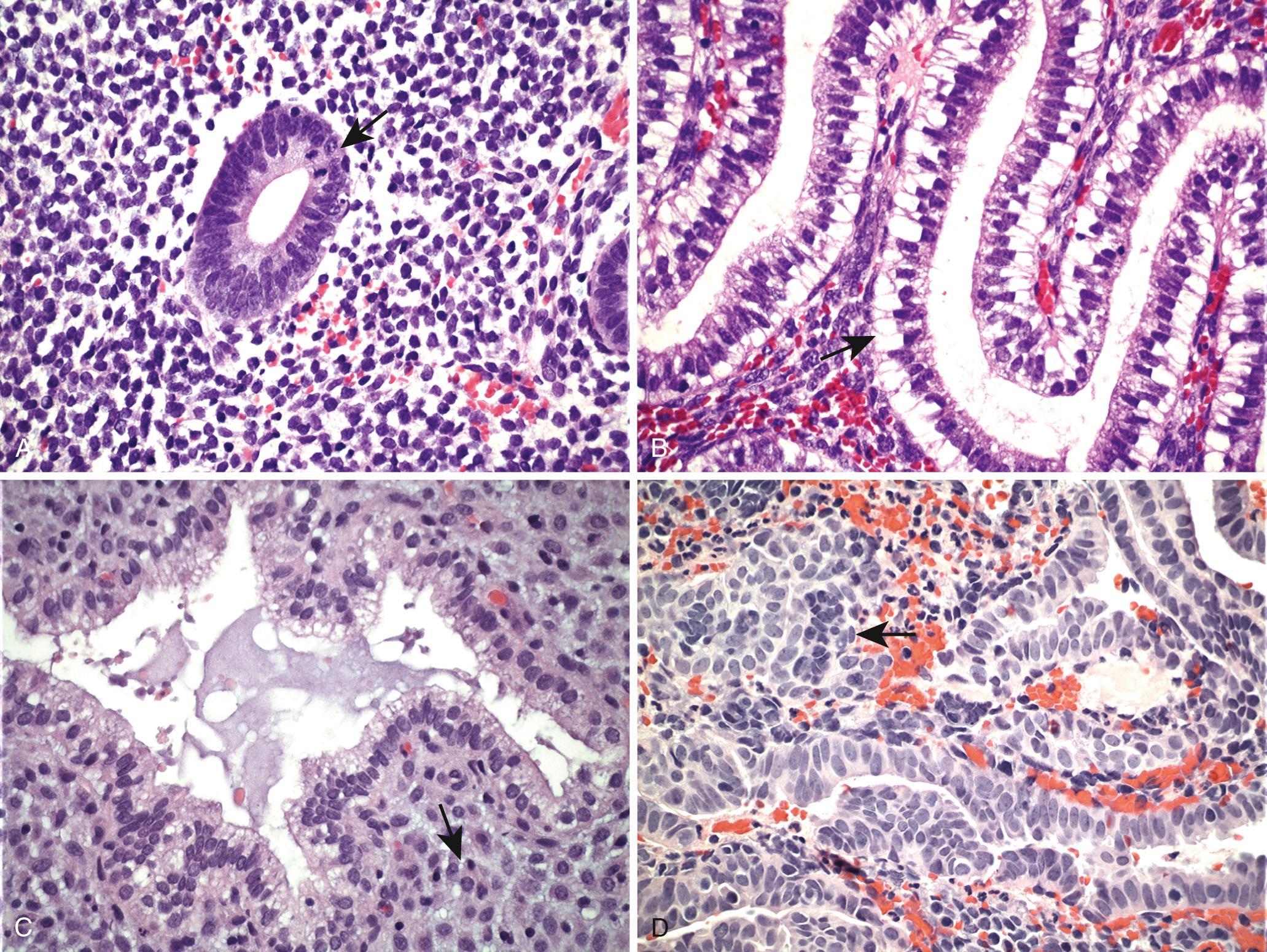
The action of the ovarian hormones on the endometrium primarily occurs through their cognate nuclear receptors. During the proliferative phase, estrogen drives the proliferation of both glands and stroma, sometimes by promoting “cross-talk” between these two cell types. For example, much of the effect of estrogen on glandular proliferation occurs via stromal cells, which in response to estrogen produce growth factors (e.g., insulin-like growth factor-1 and epidermal growth factor) that bind receptors expressed on the epithelial cells. During the secretory phase, progesterone down-regulates the expression of estrogen receptor in both the glands and the stroma, and as a result endometrial proliferation is suppressed. Progesterone also promotes the differentiation of the glands and causes functional changes in the stromal cells. Endometrial stem cells have been identified that likely have a central role in the regeneration of the endometrium after menses. They may also contribute to the development of ectopic endometrial tissue and endometrial cancer.
Although abnormal uterine bleeding can be caused by well-defined pathologic conditions, such as chronic endometritis, endometrial polyps ( Fig. 22.20C ), submucosal leiomyomas (see Fig. 22.20D ), or endometrial neoplasms, it most commonly stems from hormonal disturbances that produce dysfunctional uterine bleeding ( Table 22.3 ). This is a clinical term for uterine bleeding that lacks an underlying structural abnormality. As discussed earlier, the normal cyclical proliferation, differentiation, and shedding of the endometrium requires that all the involved pituitary and ovarian hormones be released at the proper time in the right amounts . Any disturbance of this finely tuned system may result in dysfunctional uterine bleeding, the most common causes of which are discussed in the following sections .
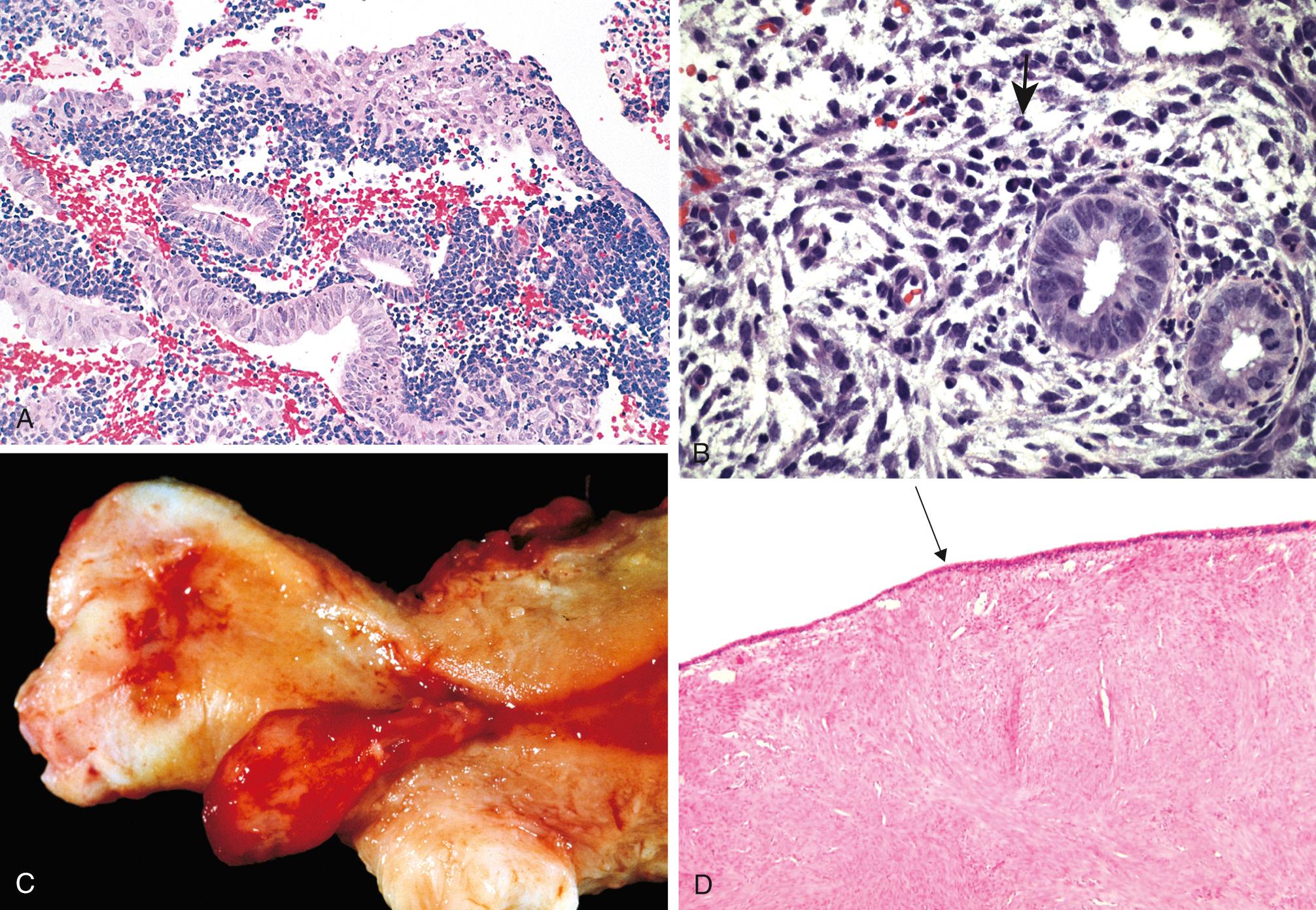
| Age Group | Causes |
|---|---|
| Prepuberty | Precocious puberty (hypothalamic, pituitary, or ovarian origin) |
| Adolescence | Anovulatory cycle, coagulation disorders |
| Reproductive age | Complications of pregnancy (abortion, trophoblastic disease, ectopic pregnancy) Anatomic lesions (leiomyoma, adenomyosis, polyps, endometrial hyperplasia, carcinoma) Dysfunctional uterine bleeding Anovulatory cycle Ovulatory dysfunctional bleeding (e.g., inadequate luteal phase) |
| Perimenopausal | Dysfunctional uterine bleeding Anovulatory cycle Anatomic lesions (carcinoma, hyperplasia, polyps) |
| Postmenopausal | Endometrial atrophy Anatomic lesions (carcinoma, hyperplasia, polyps) |
The most frequent cause of dysfunctional bleeding is anovulation (failure to ovulate). Anovulatory cycles result from hormonal imbalances and are most common at menarche and in the perimenopausal period. Less commonly, anovulation is the result of the following:
Endocrine disorders, such as thyroid disease, adrenal disease, or pituitary tumors
Ovarian lesions, such as a functioning ovarian tumor (granulosa cell tumors) or polycystic ovaries (see the Ovaries section later in this chapter)
Generalized metabolic disturbances , such as obesity, malnutrition, or other chronic systemic diseases
Failure of ovulation results in excessive endometrial stimulation by estrogens that is unopposed by progesterone. Under these circumstances, the endometrial glands undergo mild architectural changes, including cystic dilation, that usually resolve due to a subsequent ovulatory cycle. However, repeated anovulation may result in bleeding that, in certain clinical situations, may prompt an endometrial biopsy. In this setting, biopsies reveal stromal condensation and eosinophilic epithelial metaplasia, features similar to those seen in menstrual endometrium. However, unlike menstrual endometrium, progesterone-dependent morphologic features (e.g., glandular secretory changes and stromal pre-decidualization) are absent because the source of progesterone, the corpus luteum, does not develop without ovulation. Most commonly, the endometrium is composed of pseudostratified glands and contains scattered mitotic figures (see Fig. 22.20A ). More severe consequences of repeated anovulation are discussed in the Endometrial Hyperplasia section later in this chapter.
The endometrium and myometrium are relatively resistant to infections, primarily because the endocervix forms a barrier to ascending infection. Thus, although chronic inflammation in the cervix is common and usually insignificant, it is of concern in the endometrium.
Acute endometritis is uncommon and limited to bacterial infections that arise after delivery or miscarriage. Retained products of conception are the usual predisposing factors; the causative agents include group A hemolytic streptococci, staphylococci, and other bacteria. The inflammatory response is chiefly limited to the stroma and is entirely nonspecific. Removal of the retained gestational products by curettage and antibiotic therapy promptly clears these infections.
Chronic endometritis occurs in association with the following disorders:
Chronic pelvic inflammatory disease
Retained gestational tissue, postpartum or postabortion
Intrauterine contraceptive devices
Tuberculosis, either from miliary spread or, more often, from drainage of tuberculous salpingitis. Endometrial tuberculosis is rare in high income countries.
The diagnosis of chronic endometritis rests on the identification of plasma cells in the stroma (see Fig. 22.20B ), which are not seen in normal endometrium. In about 15% of cases, no cause is apparent. Some women with this so-called “nonspecific” chronic endometritis have gynecologic complaints such as abnormal bleeding, pain, discharge, and infertility. Chlamydia may be involved and is commonly associated with both acute (e.g., neutrophils) and chronic (e.g., lymphocytes, plasma cells) inflammatory infiltrates. The responsible organisms may not be detected by culture. If infection is suspected on clinical grounds, antibiotic therapy is indicated, even in the face of negative cultures, as it may prevent other sequelae (e.g., salpingitis).
Become a Clinical Tree membership for Full access and enjoy Unlimited articles
If you are a member. Log in here